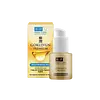What's inside
What's inside
 Key Ingredients
Key Ingredients

 Benefits
Benefits

 Concerns
Concerns

 Ingredients Side-by-side
Ingredients Side-by-side

Water
Skin ConditioningButylene Glycol
HumectantGlycerin
HumectantPPG-10 Methyl Glucose Ether
Skin ConditioningHydroxyethyl Urea
HumectantDiglycerin
HumectantPEG-32
HumectantTriethyl Citrate
MaskingGlycosyl Trehalose
Emulsion StabilisingUrea
BufferingSorbitol
HumectantCarbomer
Emulsion StabilisingPEG-75
HumectantDiethoxyethyl Succinate
SolventPhenoxyethanol
PreservativeDisodium Succinate
MaskingSodium Hyaluronate
HumectantPotassium Hydroxide
BufferingPolyquaternium-51
Skin ConditioningHexylglycerin
HumectantDisodium EDTA
Succinic Acid
BufferingHydrolyzed Hyaluronic Acid
HumectantSodium Acetylated Hyaluronate
HumectantAmmonium Acrylates Copolymer
Hydroxypropyltrimonium Hyaluronate
Pentylene Glycol
Skin ConditioningSodium Hyaluronate Crosspolymer
HumectantMethylparaben
PreservativeWater, Butylene Glycol, Glycerin, PPG-10 Methyl Glucose Ether, Hydroxyethyl Urea, Diglycerin, PEG-32, Triethyl Citrate, Glycosyl Trehalose, Urea, Sorbitol, Carbomer, PEG-75, Diethoxyethyl Succinate, Phenoxyethanol, Disodium Succinate, Sodium Hyaluronate, Potassium Hydroxide, Polyquaternium-51, Hexylglycerin, Disodium EDTA, Succinic Acid, Hydrolyzed Hyaluronic Acid, Sodium Acetylated Hyaluronate, Ammonium Acrylates Copolymer, Hydroxypropyltrimonium Hyaluronate, Pentylene Glycol, Sodium Hyaluronate Crosspolymer, Methylparaben
Water
Skin ConditioningGlycereth-26
HumectantGlycerin
HumectantNiacinamide
SmoothingPropanediol
SolventButylene Glycol
Humectant1,2-Hexanediol
Skin ConditioningDiglycerin
HumectantPanthenol
Skin ConditioningPolyglycerin-3
HumectantAcrylates/C10-30 Alkyl Acrylate Crosspolymer
Emulsion StabilisingTromethamine
BufferingBetaine
HumectantXanthan Gum
EmulsifyingEthylhexylglycerin
Skin ConditioningAdenosine
Skin ConditioningHydrolyzed Hyaluronic Acid
HumectantHydroxypropyltrimonium Hyaluronate
Hyaluronic Acid
HumectantHippophae Rhamnoides Fruit Extract
Skin ConditioningRosa Canina Fruit Extract
AstringentDisodium Phosphate
BufferingMaltodextrin
AbsorbentCaprylic/Capric Triglyceride
MaskingSodium Phosphate
BufferingSaccharide Isomerate
HumectantGlyceryl Caprylate
EmollientMyrciaria Dubia Fruit Extract
Skin ConditioningSodium Hyaluronate
HumectantAlgae Extract
EmollientSodium Citrate
BufferingBrassica Rapa Leaf Extract
Skin ConditioningCitric Acid
BufferingCyanocobalamin
Skin ConditioningWater, Glycereth-26, Glycerin, Niacinamide, Propanediol, Butylene Glycol, 1,2-Hexanediol, Diglycerin, Panthenol, Polyglycerin-3, Acrylates/C10-30 Alkyl Acrylate Crosspolymer, Tromethamine, Betaine, Xanthan Gum, Ethylhexylglycerin, Adenosine, Hydrolyzed Hyaluronic Acid, Hydroxypropyltrimonium Hyaluronate, Hyaluronic Acid, Hippophae Rhamnoides Fruit Extract, Rosa Canina Fruit Extract, Disodium Phosphate, Maltodextrin, Caprylic/Capric Triglyceride, Sodium Phosphate, Saccharide Isomerate, Glyceryl Caprylate, Myrciaria Dubia Fruit Extract, Sodium Hyaluronate, Algae Extract, Sodium Citrate, Brassica Rapa Leaf Extract, Citric Acid, Cyanocobalamin
 Reviews
Reviews

Ingredients Explained
These ingredients are found in both products.
Ingredients higher up in an ingredient list are typically present in a larger amount.
Butylene Glycol (or BG) is used within cosmetic products for a few different reasons:
Overall, Butylene Glycol is a safe and well-rounded ingredient that works well with other ingredients.
Though this ingredient works well with most skin types, some people with sensitive skin may experience a reaction such as allergic rashes, closed comedones, or itchiness.
Learn more about Butylene GlycolDiglycerin is a humectant. It is derived from glycerin, which is naturally found in your skin.
As a humectant, it helps draw moisture to the skin from the air.
Glycerin is already naturally found in your skin. It helps moisturize and protect your skin.
A study from 2016 found glycerin to be more effective as a humectant than AHAs and hyaluronic acid.
As a humectant, it helps the skin stay hydrated by pulling moisture to your skin. The low molecular weight of glycerin allows it to pull moisture into the deeper layers of your skin.
Hydrated skin improves your skin barrier; Your skin barrier helps protect against irritants and bacteria.
Glycerin has also been found to have antimicrobial and antiviral properties. Due to these properties, glycerin is often used in wound and burn treatments.
In cosmetics, glycerin is usually derived from plants such as soybean or palm. However, it can also be sourced from animals, such as tallow or animal fat.
This ingredient is organic, colorless, odorless, and non-toxic.
Glycerin is the name for this ingredient in American English. British English uses Glycerol/Glycerine.
Learn more about GlycerinHydrolyzed Hyaluronic Acid is a form of hyaluronic acid. It is created by the hydrolysis of hyaluronic acid with a high molecular weight. Once created, Hydrolyzed Hyaluronic Acid has a low molecular weight.
Low molecular weight HA has been shown to hydrate and increase elasticity of the skin. Increasing elasticity is also associated with reduction of wrinkle depth.
One study found topical low molecular weight hyaluronic acid may be considered for the treatment of rosacea in the adult population. However, we always recommend speaking with a professional about your skin concerns.
Hyaluronic acids are a humectant. This means they draw moisture from the air. Hyaluronic acids help moisturize, soothe, and protect the skin.
Read more about other common forms of hyaluronic acid:
Learn more about Hydrolyzed Hyaluronic AcidThis form of hyaluronic acid is produced through fermentation.
According to a manufacturer, it has a positive charge by ionic binding to help moisturize and give hair a smooth feel. This is why you'll find this ingredient in shampoos and body washes.
Sodium Hyaluronate is hyaluronic acid's salt form. It is commonly derived from the sodium salt of hyaluronic acid.
Like hyaluronic acid, it is great at holding water and acts as a humectant. This makes it a great skin hydrating ingredient.
Sodium Hyaluronate is naturally occurring in our bodies and is mostly found in eye fluid and joints.
These are some other common types of Hyaluronic Acid:
Learn more about Sodium HyaluronateWater. It's the most common cosmetic ingredient of all. You'll usually see it at the top of ingredient lists, meaning that it makes up the largest part of the product.
So why is it so popular? Water most often acts as a solvent - this means that it helps dissolve other ingredients into the formulation.
You'll also recognize water as that liquid we all need to stay alive. If you see this, drink a glass of water. Stay hydrated!
Learn more about Water